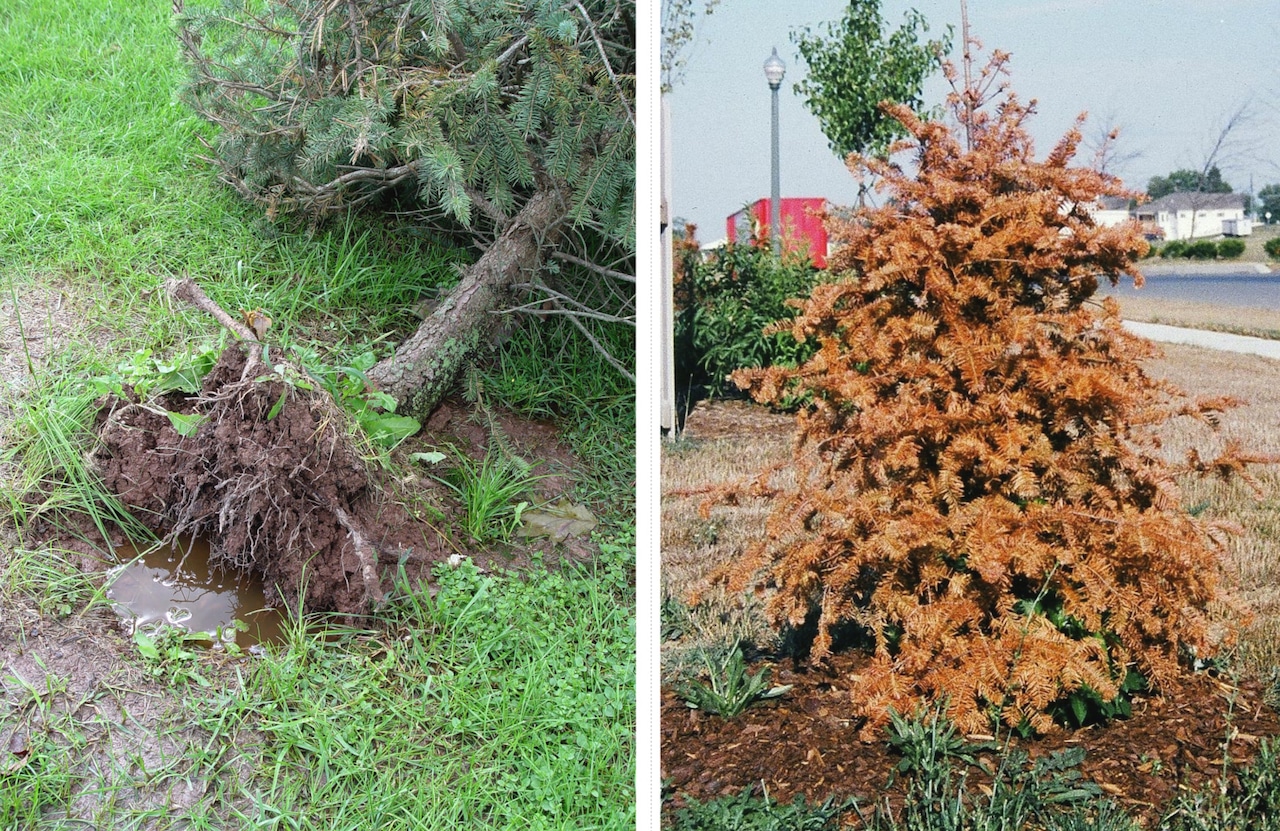Copyright Mechanicsburg Patriot News

So how can we have landscape plants damaged and dead from “drought” in a growing season that was wetter than normal? The answer lies in how the rains came this year. While the Harrisburg area’s official rainfall total checked in almost three inches above normal during the six key growing months of April through September, almost half of it came in a single month. That would be May 2025, which set an all-time Harrisburg monthly rainfall record of 10.02 inches, way beyond the May norm of 3.83 inches. But then rain all but disappeared during an eight-week stretch from August through September, drying the soil deep enough and long enough to cause plant damage during what should be prime growth months. That exposed the watering Achilles heel of plants … it’s not the total rain you get that counts but when and how you get it. In other words, plants need effective rainfall. That’s not what we got this year in the “rollercoaster rainfall” that’s a hallmark of our recent erratic and more extreme climate. Our summers have generally been hotter and drier in the past two decades. Our winters are warmer and wetter with rain and sleet replacing yesteryear’s snow. Temperature swings are more erratic, and root-killing rain soakings are alternating with so-called “flash droughts.” “Extreme weather is about 10 times more likely now than in the past, and each year seems to be worse than the one before,” says Penn State landscape and ecosystem ecologist Erica Smithwick. This year was a poster child for that. Trouble for gardeners started last fall when the soil went into winter abnormally dry. That’s a problem for evergreens in particular, which continue to lose moisture all winter through their leaves and needles at a time when the roots are unable to replace that moisture due to frozen ground. Winter didn’t bail us out. Despite 10 inches of snow in January, both January and February checked in drier than usual. A late-January Arctic blast further punished those dry-stressed evergreens and borderline-hardy plants with three straight nights of sub-zero temperatures, bottoming out at minus-7 degrees on Jan. 22. Rain happened only three days in March (another 1.37-inch deficit), and even April gave plants only 2.28 inches of drink (1.27 inches under the norm). That’s when the drastic switcheroo came. Rain fell on 25 of May’s 31 days — enough to saturate soil and rot plant roots. Penn State Master Gardener Shirley Halk, who chairs Dauphin County Extension’s Garden Hotline, says a bigger problem was with “gardeners not being able to get into the garden at the proper time. It was too wet. More people started later in the year, and because of that, had to make different plant selections.” All of the moisture also fueled worse-than-usual troubles leaf disease, she adds, primarily powdery mildew on plants such as beebalm, lilacs, and some vegetables. After a mixed bag in June and July, the rollercoaster plummeted, delivering one of our driest Augusts statewide in decades. September followed with another deficit of more than three inches. The rain that did fall was very spotty, too. “Where I may be getting four inches of rain,” says Halk, “a half a mile from me might be getting a half an inch. So it’s the luck of the draw.” Recently planted plants with their limited root systems suffered the most. The same gardeners who watched plants die in May’s soggy soil ended up on never-ending hose duty in late summer, fretting over wilted hydrangeas, browning lawns, and dying tree branches. Unfortunately, this kind of extreme, erratic weather is becoming the new norm. “Southcentral and southeastern Pennsylvania have been in and out of abnormally dry and moderate drought classifications throughout the past year, especially during critical times of the growing season,” says Erin Kinley, Penn State Extension’s statewide Master Gardener coordinator. “For many years now, we have also been seeing larger, heavier rainfalls with longer dry periods in between.” “This isn’t a once-and-done deal,” adds Halk. “It’s the new conditions we should get used to … intense heat, intense drought, intense rain.” Halk believes it’s time for gardeners to shift gears and go with the flow (or lack of it, as the case may be). She says gardeners would be wise to lean toward heat- and drought-tough plant varieties, be ready to water more than in the past, think about sun-deflecting plant protectors in the worst of summer heat, and adapt to new timing and other gardening strategies that play into the climate hand we’re being dealt. A big part of the problem is that our landscape plants aren’t able to adapt as fast as the climate has been changing. That goes both for temperature and soil moisture. While the loss is fairly minor when a washout wipes out the tomatoes or a summer flash drought kills the petunias, it’s a different story with trees, shrubs, and evergreens. They’re a bigger investment and more painful to lose. Halk fears we’re going to realize the full impact of this season’s troubles next spring when trees fail to leaf out and evergreens turn into everbrowns. “After winter, we’re going to see a definite impact on trees,” she says. “I think we’re going to see a decline.” Researchers at Longwood Gardens in Chester County and at Chicago Botanic Garden already have documented tree species that are struggling in our warming weather — ones that include American beech, black cherry, gray birch, and sugar maple. They and others say it makes sense to plant for the climate that’s coming, not the one we’ve had. So while we might have a harder time growing cool-preferring spruces, firs, and heathers, the increasing warmth could open the door to plants that our winters used to kill, such as osmanthus, camellias, laurels, Chinese fringe flowers, aucubas, and photinias. The caveat, though, is that brief but sudden dips into sub-zero range are still possible (see this past Jan. 21-23), posing a risk to those more warm-adapted species. Rollercoaster rainfall is equally perplexing. University of Georgia agricultural climatologist Pam Knox says there’s a difference between a meteorological drought and an agricultural drought. “A meteorological drought is related to how much rain you get compared to usual conditions at your location,” she says in a post on the Garden Professors blog. “I like to think of it as ‘too many days of nice weather in a row.’” On the other hand, she says, an agricultural drought is when soil dries enough to threaten plant health. Those can happen a lot faster, especially when rain shuts off during a hot spell. That duo can be deadly to plants even though the deeper ground water and water supplies are fine. Knox, Halk, and horticulturist Dr. Linda Chalker-Scott at the University of Washington offer some tips on how gardeners can counteract threats from the new climate: 1.) Choose water-wise plants “As we develop, add to, or change our landscapes we should choose plants that, once they’re established, will thrive without needing additional irrigation,” says Chalker-Scott. “And don’t fall into the ‘native-plants-are-more-water-use-efficient’ trap. Grow any plant outside of its original environment, or plant it in urban or compromised soils in a micro-climate it’s not adapted to, and guess what — native plants can be water hogs, too.” In general, plants with smaller and thicker leaves are more resistant to drought than plants with large and thin leaves. Halk says some of the plants she’s seen do well in this year’s adversity include verbena (annual and perennial), lantana, amsonia, succulents, low-growing sedums, asters, goldenrod, creeping thyme, and ornamental grasses like little bluestem and switchgrass. Penn State Extension has an online list of regionally adapted plants that tolerate drought. 2.) Group plants by their water needs “If possible, don’t mix plants with different water needs in the same planting bed,” says Chalker-Scott. It’ll be easier to water more efficiently if you group drought-tough plants in one bed and water-needy plants in another. 3.) Figure on watering more often in summer “If people had irrigation or water, it made a really big difference this year,” says Halk. She says drip-irrigation systems are an increasingly good option. Otherwise, gardeners should keep the hose handy, and use it before plants begin showing signs of drought stress. Chalker-Scott says “indicator plants” make good alerts for when it’s time to water. These are fast wilters such as hydrangeas, ligularia, rodgersia, impatiens, and astilbes. Also helpful is mulching to retain soil moisture. 4.) Keep a close eye on your soil moisture What counts more than “official” rainfall totals from a central site is how much rain is in the root zone around the plants in your yard. The best way to track that is by inserting a water gauge or probe into the ground. “A soil probe can be anything long and sturdy enough to penetrate the soil at least 12 inches,” says Chalker-Scott. “Long screwdrivers, skewers, even the spit from an old rotisserie grill will all work.” Use firm pressure to insert the probe until you meet resistance. That’s generally where adequate soil moisture ends. 5.) Be ready for too much water Rain gardens, which channel rain runoff into purposely well drained beds planted with species that can tolerate occasional wet soil, are increasingly smart options. Planting more trees and gardens in general is another good way to control and capture runoff. If there’s too much water to capture, consider digging swales, French drains, or stone-lined channels to carry runoff in less damaging, more controlled ways. 6.) Lean toward more heat-resistant plant varieties A good tool here is the USDA plant hardiness zone ratings that are listed on plant tags and labels. Now that USDA zones are inching upwards as winters warm, it makes sense to shift away from ones rated for colder climates and towards ones rated for warmer climates. Much of the Harrisburg area is now listed as USDA Zone 7a, up from last decade’s Zone 6b. 7.) Rethink planting schedules Earlier springs and later falls have extended our frost-free growing season. Take advantage by getting an earlier start planting landscape plants in spring (end of March most years) as well as planting frost-hardy vegetables such as cabbage, broccoli, and lettuce a little sooner (so they’re not trying to mature in our earlier-arriving summer heat). The extended back end of the season gives a little longer for fall landscape plantings (through October and maybe beyond) and more time to grow a fall crop in the vegetable garden.



